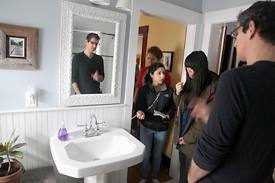Imagine if your home had walls filled with water, toilets that composted their own waste and a roof capable of disinfecting water through the sun’s ultraviolet rays. This vision may become a reality for one Ann Arbor home, as a group of students from the College of Engineering work to retrofit a 100-year-old Victorian to capture and treat its own water.
The home belongs to the Grocoff family and is an unassuming structure in the heart of the city’s “Old West Side.” It already has achieved recognition as one of the country’s first Net Zero Energy homes — meaning the house produces more energy through the use of solar panels and geothermal than it consumes.

Members of the Michigan Engineering student team BLUELab tour a house in Ann Arbor for which they will design and implement a Net Zero Water system. Photo by Marcin Szczepanski.
Now, owner Matt Grocoff and the team of Michigan Engineering students hope to accomplish that same feat with water — something that, to their knowledge, has never been done on this type of structure. Their goal is to capture and treat enough rainwater on site to supply the house with clean drinking water, and then find creative solutions for recycling or reusing wastewater for cleaning or irrigation.
“I’m so excited to be working with the team on this, because this challenge is so big that no one person could accomplish it on their own,” said Grocoff, a Net Zero Energy consultant and creator of GreenovationTV.com.
Grocoff and the team from Better Living Using Engineering Laboratory (BLUElab), a student-run organization, will spend the coming months brainstorming, prototyping and testing several design options that could achieve the goal of Net Zero Water.
The students began their journey on an appropriately rainy day in February, as they toured the home. After the tour, about a dozen engineering students listened as Grocoff explained his journey to Net Zero Energy conversion — and his hope to accomplish the same thing with water.
“Net Zero Energy is easy,” said Grocoff. “Now the real challenge is water. The largest expense after street lighting in most municipalities throughout the country is sewers and water treatment.”
The venture kicks off as the City of Ann Arbor undertakes one of the largest capital improvement projects in its history — rebuilding half the city’s wastewater treatment plant at a pricetag of $120 million.
“We take highly treated water and use it for many reasons — we drink it, we clean with it, we even pee into it. Then we dump it all back into one pipe,” said Grocoff. “The question is, can we rethink this system?”
According to the U.S. Environmental Protection Agency, Americans use about 100 gallons of clean, drinkable water per person each day. But only about 15 gallons of that is used for cooking, drinking or brushing our teeth. Almost half is used by flushing the toilet and showering.
“When people think about sustainability, they like to think about the future,” said Steven Skerlos, an Arthur F. Thurnau professor of mechanical engineering and faculty adviser for BLUElab. “But water shortage is not a future problem. It’s happening right now.”
The effort to increase consumer awareness about consumption and conservation has been going on for years, but actively retrofitting existing homes to create their own usable water is a relatively new undertaking.
“I’m very passionate about sustainable retrofitting because it’s important for us to live within our means on this planet. And it’s also just such a challenging project — what do we do with the 130 million U.S. homes that are already here?” said Devki Desai, a doctoral student in civil engineering and team leader of the project.
The team hopes to retrofit the home to ultimately qualify for certification in the Living Building Challenge. Challenges such as these are prompting builders to consider green solutions for new projects, but the average American home is being left behind, said Grocoff, who believes what’s so unique about his home is that it’s so ordinary.

